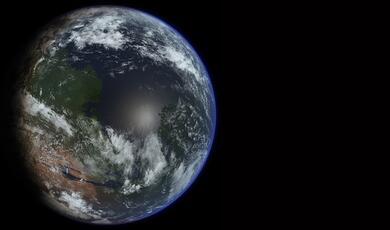A voyage round Saturn, its rings and moons
Share
- Details
- Text
- Audio
- Downloads
- Extra Reading
Saturn is the most beautiful planet in our Solar System. Famous for its bright yet ethereal rings, the gas giant has over sixty natural satellites in orbit around it – and one artificial satellite: NASA’s Cassini spacecraft, which provides many of the results and images that will be showcased in this talk. We shall explore the weather observed in the atmosphere of Saturn, the curious structures that develop within the rings, and its wide variety of moons – from smog-shrouded Titan, two-sided Iapetus, to busy Prometheus, and the icy plumes erupting from frozen Enceladus.
Download Text
2 November 2011
A Voyage Round Saturn, its Moons and Rings
Professor Carolin Crawford
INTRODUCTION
Saturn is the most distant planet easily visible to the unaided eye, and as such it has been watched closely since prehistoric times. Its particular mystery was only unveiled when Galileo Galilei first turned his simple optical telescope to it in 1610, and immediately noticed something strange about the planet. At first he guessed that its elongated shape was due to a couple of large moons to either side of Saturn; two years later these had disappeared, only to be replaced by two arched ‘cup handles’ to the planet by 1616. It wasn’t until Christiaan Huygens was able to observe Saturn with a much improved version of a telescope in 1659 that the mystery was resolved, when he identified the two ‘handles’ as a ring encircling the planet. Huygens also discovered Saturn's largest moon, Titan. A few years later, Jean-Dominique Cassini discovered a further four moons of Saturn, and resolved the surrounding ring into a series of rings, separated by gaps – the most apparent of these gaps has since been named for him. Today we have the opportunity to scrutinise Saturn in detail, with the luxury of remote exploration by robotic spacecraft; and yet the planet and its complex system of rings and moons remains intriguing.
Saturn has been visited by spacecraft only four times. Three were brief flybys: Pioneer 11 in 1979, followed by Voyagers 1 and 2 in 1980 and 1981. In June 2004, the Cassini spaceprobe (named for the 17th Century astronomer) reached Saturn after a 7-year voyage, and it has been in orbit around the planet since. Cassini is an international scientific mission, carrying a range of complex instruments, including cameras that can image in both visible and the infrared. Originally designed for a 4-year operation, Cassini’s mission has been extended twice due to its success. Virtually all the spectacular images included in this lecture are ones taken by Cassini.
SOME STATISTICS
Saturn is the sixth planet out from the Sun, and takes 29.5 Earth-years to revolve once around the Sun at an average distance 9.5 times larger than the orbit of the Earth. So far out it receives only about 1% of the sunlight and heat that we do at Earth, so it is much colder, with a mean temperature in its atmosphere of around -125°C. It is the second largest planet in the Solar System, with a diameter of 9.5 Earths – and a volume large enough to fit 760 Earths within it – and a mass 95 times that of Earth. This ratio of mass and volume immediately implies that Saturn is not very dense. In fact it has the lowest density of all the planets in our Solar System, and at 0.687 g/cm3 is less dense than water (at the temperature and pressure of Earth). Saturn is thus primarily composed of only the lightest elements, such as hydrogen and helium in both their gaseous and liquid states.
Despite being so much larger than the earth, Saturn rotates once on its axis on average about every ten and a half hours. Along with other gas giant planets, it doesn’t rotate in the same way as a rocky planet like the Earth, with all parts of the surface rotating together at the same rate. Instead different latitudes of the planet are seen to spin at different rates in what is known as ‘differential rotation’. The Saturnian day is some 25 mins longer at the poles than at the equator. This confirms the idea that Saturn is not solid throughout, but is made up of much more fluid materials rather than solid rock and metal. It spins so quickly that the planet is slightly flattened, the matter in the planet flung outward by the rotational motion to make it 10% wider at the equator than at poles.
SATURN’S ATMOSPHERE
The ‘surface’ of Saturn that we can see is merely the top of the clouds high in its atmosphere, which have been stretched by the planet’s rapid rotation until they wrap right around to form coloured bands. The highest clouds are largely composed of ammonia crystals, frozen out at temperatures as low as -250°C. 170km lower down are layers of ammonium hydrosulphide clouds at a warmer temperature of -70°C, where the presence of sulphur provides the characteristic warm orange hue. The lowest cloud deck is made of water clouds, at temperatures around 0°C. These visible clouds overlay an atmosphere primarily made of molecular hydrogen, but only recognisable as a gas for the outermost several hundred km.. Below this, the weight of the overlying layers of material starts to squeeze the gas, compressing it with the result that the pressure and temperature increase rapidly with depth. Soon the hydrogen and helium ‘gas’ becomes very dense and as incompressible as a liquid.
As the pressure rises ever higher deeper into the atmosphere, the hydrogen changes into an even more unusual form. Nuclei are so squashed together that instead of two hydrogen nuclei sharing electrons to form a molecule, a large number of nuclei share electrons in a bonding pattern similar to that found in a liquid metal. This rapidly rotating layer of atmosphere is thus electrically conducting, and is responsible for generating Saturn’s strong magnetic field. Below all these layers is a soupy mixture of water, methane and ammonia ice, all liquified under the extreme high temperatures and pressures. At the very centre is a rocky/metal/ice core, with a mass between 5 and 10 Earth masses, and which is most likely composed of typical rocky planet materials such as silicate and iron compounds. By this stage, the centre of the planet is at temperatures just short of 12,000°C.
Saturn is observed to radiate twice as much energy as it receives from the Sun, so it must generate its own heat. In infrared light the warm interior of the planet can be seen to shine through the deeper cloud layers in the atmosphere. This heat is not a remnant of that liberated during the original gravitational collapse and formation of Saturn, but is thought to come from the ‘metallic’ region of the atmosphere, where heavier helium condenses into drops that separate out from the hydrogen, falling faster towards the core and releasing gravitational energy as heat. Along with the incident sunlight, the heat rising from the interior provokes weather systems in the clouds, along with jet streams that can reach speeds of up to 500 m/s near the equator of Saturn. All of this provokes massive and long-lived storms swirling in the clouds. Hurricane-like vortices are often observed embedded in the cloud belts in the ‘storm alley’ region 35 degrees south of the equator. A seasonal storm known as the ‘Great White Spot’ is caused by an upwelling of warmer air from deep layers in the atmosphere, where ammonia ice crystals form in the frozen cloud tops at the top of the thunderhead. Its appearance is associated with the portion of Saturn’s orbit when its Northern hemisphere tilted more towards the Sun. The latest Great White Spot emerged rapidly late in 2010, and expanded rapidly in longitude until it encircled the planet, some 15,000 km across and over 300,000 km long.
The most spectacular swirling storm systems develop above the poles of the gas giant. That above the South Pole is easily the size of the Earth, with a well-developed wall surrounding the eye, and winds that reach twice that of a Category 5 hurricane. A much weirder system hovers above the North Pole; originally discovered during the Voyager flybys, the clouds of the storm rotate in a hexagonal pattern of six equal sides that has remained stable to this day. It is an even larger storm than that at the South Pole, as a total of four Earths could be swallowed up by the hexagon. Although the origin of the unique structure is not fully determined, laboratory experiments by physicists Ana Claudia Barbosa Aguiar and Peter Read of the University of Oxford suggest that small eddies arise from the interaction between a north polar jet stream and the rotation of the rest of the atmosphere. These small vortices then squeeze the clouds into the only six-sided storm in the Solar System, the shape of the polygon determined by the relative speeds of the jet stream and spinning atmosphere.
SATURN’S RINGS
However, it is Saturn's system of rings that makes the planet one of the most beautiful objects in the cosmos. Even though the brighter inner rings extend from 6,600 to 120,000 km above Saturn's equator, they are on average only about 100m thick – if scaled down to 2km across they would be thinner than a sheet of paper. The inclination of the ring system as viewed from Earth changes during Saturn’s 29 and a half year journey round the Sun, appearing to change in shape from being wide open when face-on, to almost invisible when edge-on. It was this phenomenon that so mystified Galileo when first observing the planet. The variation in aspect is caused because the ring system – along with the rest of Saturn – is tilted relative to the plane of Saturn’s orbit by 27°, so the planet tilts first one hemisphere, then the other, towards us. The last time the rings were edge-on to us was in September 2009, and since then they have been slowly opening up again, and will continue to do so till they reach a maximum aspect next on October 16, 2017. At that point, the extra reflection of sunlight provided by the rings contributes to making Saturn almost as half as bright as when the rings are edge-on.
Unlike many features of planets in the Solar System, these rings do not have an elegant nomenclature, but are lettered A, B, C..., according to the order of their discovery. The outer of Saturn’s two brightest rings is the A ring, which is partially transparent, and surrounds the inner more opaque B ring. Inside the B ring is a much fainter, darker C ring, and at the very centre of the system lies the dim and fuzzy D ring. Beyond the A ring is a very narrow F ring that was only discovered by Pioneer 11 in 1979, and the two much larger, very tenuous E and G rings. Each ring is observed to rotate at a different rate – the inner edge of the C ring completes an orbit within 5.8 hours, compared to 14.3 hours at the outer edge of the further A ring. This means that the rings cannot be a solid sheet of matter, as the difference in rotation would rip them apart. Instead they are composed of a multitude of particles, each on its individual orbit around Saturn like a miniature moon, and grouped into thousands of separate ringlets. Observation of the rings with Cassini in the infrared and radio demonstrate that the size of the particles composing the rings ranges from miniscule dust-like particles in the E and D rings, up to larger particles on the scale of sand grains or pebbles by the C and A rings. The largest lumps, up to the size of small boulders reside in the B ring. All the particles are separated by around 5 to 10 times their size, and so are not crowded tightly together. It is thought that the rings were formed some 100 million years ago when a small moon – probably some 300 - 400km in size – shattered into pieces by the tidal forces created by Saturn’s gravity. The multi-wavelength observations show that the rings (and presumably the original moon) are composed mainly of water ice, with a small dust contaminant.
As observed by Giovanni Cassini in 1675, there are gaps within the rings, most obviously the Cassini division separating the A and B rings. Other divisions include Encke and Keeler gaps which split the outer part of the A ring. The gaps are not completely empty, although some are swept clear by small moons embedded within them. Cassini imaged the rings when they were oriented edge-on to the Sun, and any deviations in height cast exaggerated shadows across the ring face. Such observations reveal clumps of material along the outer edge of the B ring, disturbed to stretch up to 3km above the plane of the rings by a temporary passage of a moon. In other locations rings are sculpted into rippling corrugations of crests and dips; even though the nearby moons are small, their gravitational attraction is sufficient to temporarily redistribute and clump the particles. The effect of the gravitational perturbation is accentuated when the particles’ orbits are in a fixed ‘resonance’ ratio with the orbit of a moon, building in importance due to continual repetition. For example, the 8-km wide moon Daphnis lives in the Keeler Gap, but follows a slightly inclined orbit, and its gravity shapes the particles at the edge of the gap into temporary crest in both the vertical and horizontal directions.
Such moons are known as ‘shepherd’ moons, from the way that they organise and shape the particles in the rings. One such is 100 km-wide Prometheus, a potato-shaped moon that follows an elliptical orbit within Saturn’s F ring. At the outer point of this path it is close enough to the inner edge of the F ring to draw particles away from the ring, forming a streamer in its wake. Material in the ring is orbiting slower than the moon, so each time they meet, Prometheus pulls out a streamer from a position in the ring slightly ahead than on its last visit. The result is a cycle of kinks and channels that braid the ring, each dissipating away before Prometheus cycles round to meet that portion of the ring again.
THE MOONS OF SATURN
Saturn has an extensive family of at least 62 moons, ranging from moonlets less than a kilometre across up to gigantic Titan which is larger than the planet Mercury. Only seven of the moons are sufficiently large to be spherical in shape, with only thirteen wider than 50km across. Most of them orbit directly above Saturn’s equator, in the same plane as Saturn’s rings. Several (such as Pan, Atlas and Pandora) are shepherd moons associated with gaps in Saturn’s rings like Daphnis and Prometheus. The other moons occupy the vast distance between the A and G rings.
THE IRREGULAR SATELLITES
Over half of the moons are termed irregular satellites, with characteristics that imply an origin outside of the Saturnian system. The best example is Phoebe, the most distant of Saturn’s moons. It not only orbits Saturn along a path greatly inclined at 152° to the ring plane, but it revolves in the opposite direction to the movement of both Saturn and its rings. Its surface is irregular, heavily cratered and much darker than the other moons, covered with deposits of carbon dioxide and other organic material. These moons could have originally been occupants of the distant Kuiper belt (or the debris from collisions between such members), out at the far edges of the Solar System beyond Neptune, and became captured by Saturn’s gravity when they ventured too close.
Epimetheus and Janus are two small moons just at the outer edge of the A ring, similar in both size (about 110km in diameter) and composition, each showing an irregular shape under a cratered surface. They are the only example of co-orbiting moons in the Solar System, following orbits separated by only 50km from each other. They could well have formed from the breakup of the same parent body. The moon on the inner orbit travels slightly slower than the other, and so they only align every 4 years. When they approach each other, however, they do not collide as one might expect, but exchange energy and orbits. The outer satellite pulls on the inner one to slow it down, and the inner pulls on the outer to speed it up. By Kepler’s laws of motion, the slower moon must inhabit the larger radius orbit, so they deftly swap positions every 4 years.
Some of the smaller moons such as Telesto (24km wide) and Pandora (84km) show unusually smooth and bright white surfaces, and they well be more like piles of rubble held together by icy material than solid moons. The weirdest of the irregular moons has to be 250km-wide Hyperion. Not only does it have a very uneven shape, but it rotates in a chaotic manner, varying both its spin period and axis. The surface is composed of deep craters with sharp edges, coated with dark matter some tens of metres thick at their base. The moon has a very low density, suggesting that it is probably porous, with a spongy structure of caverns deep inside.
THE LARGE MOONS
Most of the seven large moons are composed of a combination of pure water ice with rock, as confirmed by both their mass densities and spectroscopy of the reflected light. The smallest of Saturn’s larger (spherical) moons is MIMAS, lying just beyond the main system of rings. Like all the moons, its surface reveals a long history of impact cratering. In particular, the massive Herschel crater (named for the discoverer of the moon) spans almost a third of the moon’s 400km diameter, with walls some 5km high. The crater is so large that the impact must have come close to shattering the moon, and it caused large stress fractures that are seen to wrap around to the opposite side of Mimas, caused by shock waves that travelled through the body of the moon. Images of the Herschel crater taken during Cassini’s close flybys show dark streaks and lines along the base of the icy crater walls, showing where pockets of carbon- or silicon-based impurities were exposed by the impact, trickling and slumping down the ice.
The largest of all the moons is giant TITAN. Discovered by Huygens in 1655, it is the second largest moon of our Solar System. Its diameter of just over 5000km makes it even larger Mercury, and just under half the size of the Earth. Its appearance is immediately different from that of the other moons, as it has a dense atmosphere that completely obscures all surface features in visible light. This atmosphere is dominated by molecular nitrogen (98%), along with methane and small amounts of other complex hydrocarbons. Despite being one of the richest stores of organic molecules within the Solar System, the fact that its surface temperature is a frozen -180°C precludes many of the complex chemical reactions that are necessary for life to have arisen. Indeed, scientists regard it as a pristine example of what the very early Earth may have looked like some 3.8 billion years ago. Within the very upper levels of the atmosphere, the ultraviolet radiation from the Sun breaks the methane molecules apart into their constituent elements of carbon, hydrogen and nitrogen, which then reassemble to make a thick haze of complex hydrocarbon compounds such as ethane and acetylene. Below these upper cloud levels, the atmosphere becomes impenetrable orange smog that only lets about 10% of the sunlight through to the surface.
Cassini has mapped out the topology of parts of Titan’s surface in a series of fly-bys of the moon, using radar imaging and altimetry. These experiments reveal mountains and plains, vast dunes and impact craters, and widespread regions of both bright and dark terrain, including a continental area around the size of Australia that has been named Xanadu. The surface temperature is around the triple point of methane, which means that it can co-exist as a solid, liquid and gas. Analogous to the water cycle on Earth, Titan has a methane cycle of clouds, rain and lakes. So far over 400 lakes of liquid hydrocarbon have been discovered from the radar imaging with Cassini, many of which are edged with bays, islands and river channels. Repeat flybys of the moon reveal how the weather can change, revealing differences in the cloud patterns and surface lakes, presumably linked by large storms and rainfall.
A few months after its arrival, Cassini dropped the cone-shaped Huygens spaceprobe, which then entered Titan’s atmosphere, taking a leisurely 2 and a half hours to float down through the clouds, its descent slowed by parachutes until it became the furthest human-made object ever to land on a Solar System body. Huygens’ on-board instruments analysed the chemical composition of the surrounding gas and clouds, and captured many images of the moon’s surface. Several show dry lakebeds and dark sinuous river channels; the probe itself landed on a surface of frozen methane and ethane. Pebbles close to the landing site clearly show signs of erosion around them, suggesting that liquid has once flowed around and under them.
TETHYS is one of the closer moons of Saturn; it is about 1000km across, and orbits well outside Saturn’s main rings. Like Mimas, it bears the scar of a particularly major collision in its past in the form of the extensive impact crater Odysseus. Along with the craters, the surface shows a landscape of long jagged ice cliffs, including the Ithaca Chasma, a canyon some 2,000km long and 100km wide. Saturn’s second-largest moon, RHEA has one of the most heavily cratered surfaces of the Solar System, with later craters overlaying the earlier structures to mar their originally circular outline. Another large moon, DIONE, also made up of water ice and rock, has widely differing hemispheres – one half has more craters than the other, while the other is smoother and brighter. Like many other moons in the Solar System (including our own Moon), it is tidally locked to its planet, meaning that it has one face always turned toward Saturn. As a consequence, one might expect that its leading half – the side that is always the first to meet any oncoming debris – should be that to show the heaviest cratering. Instead it is the trailing half that is most scarred; this is most readily explained only if it has suffered a collision in its past sufficiently enormous to have spun the moon a half-turn around on its axis.
The shiniest inner moon of Saturn is the 500km-wide ENCELADUS, which reflects nearly all the sunlight falling on it to be one of the shiniest objects in our Solar System. Because it reflects away so much energy, it is cold on the surface; about -201° C. Infrared spectroscopy indicates that the surface is almost entirely water ice. It shows surprisingly few craters; most of the surface is smooth, folded and creased into fissures alongside cracks. The lack of craters suggests that they have been erased or filled in at some point, perhaps by warm water ice leaking out across its surface. The folding of the ice traces a history of tectonic deformation, with parallel creases and ridges following sharp 90° turns in direction.
Enceladus is surprisingly active. Icy jets continually erupt from its surface, spraying plumes of water vapour, gas and tiny grains of ice out into space, hundreds of kilometres above the moon’s surface. The jets are predominantly associated with the four deepest parallel fissures in the surface affectionately known as the ‘tiger stripes’, obvious in the southern hemisphere. Thermal imaging by Cassini shows these fractures to be warmer than their surroundings by about 100°. The interior of the moon is much warmer than expected for an icy moon, as the core continually squeezed and stretched by gravitational tidal heating. A subsurface ocean is kept liquid by this warm rocky core, and should it seep out through the surface it will spread across the surface to recoat it. Evidence for this hypothesis comes from close flybys of Cassini that have repeatedly taken a path right through the icy plumes, where it is able to analyse the ice grains and determine its composition. The water ices contained traces of other materials such as sodium chloride (salt) and sodium bicarbonate (baking soda). In the same way that the Earth’s oceans have leached out sodium from prolonged contact with the underlying rock, Enceladus’ subsurface seas have dissolved minerals by being in direct contact with the rock of the core, becoming salty with time. The seawater edges up under the icy mantle, perhaps forced under pressure into caverns under the ice through a network of faults. A combination of water vapour, ice particles and the dissolved minerals are drawn up further through cracks to be sprayed out high above the surface. These plumes are responsible for populating Saturn’s very diffuse, faint and extended E ring, which is composed of very small grains, only about a micron in size. Enceladus sits at the centre of the orbit of the E ring, and when material issues from the moon it is dispersed further by the combined effects of the pressure of sunlight and Saturn’s gravitation. The small particles should only have a relatively short lifetime, so the continued presence of the ring implies that they are replenished.
The final moon to mention is IAPETUS, the third largest moon, which has an orbit some ten times further away from Saturn than the rest of the larger moons. The fact that it has one side as dark as coal, and the other as bright as snow were known even by Cassini when he discovered it in 1671, from the fact that he could only see Iapetus on the west side of Saturn. Both sides show impact craters, and detailed images of the transition region between the two sides suggest that a white landscape has been coated by a dark organic material. Only a small seeding of a dark substance is required to produce a runaway effect between two sides of the moon because Iapetus has a very long day. Any dark material acquired on the surface thus has plenty of time to absorb the Sun’s heat and warm up, causing any lighter icy species in contact with it to also heat up and sublimate away. This exposes further underlying dark surface that then absorbs more heat... and so on. The original seeding could have come from ice volcanos bringing dark hydrocarbons to the surface, but it seems to be associated rather with an external source.
One such source could be the colossal and newest ring to have been discovered around Saturn. Much broader and further out from the E ring created by Enceladus, it was discovered from its thermal infrared radiation. The outer irregular moon Phoebe sits at the centre of the ring, which shares its greatly inclined orbit. Diffuse and wide, it is created from the dusty ejecta created by micro-meteorite impacts onto the surface of Phoebe. The dust then slowly drifts in towards Saturn, where it is splattered onto the leading edge of Iapetus like flies on a car windscreen. The dark material coating the surface of Iapetus is observed to have a similar composition to the surface of Phoebe, in support of this theory.
AND FINALLY
Cassini’s greatest image has to be that taken from the night side of Saturn as it eclipses the light of the Sun. Scattered sunlight illuminates the rings, and far in the distance to one side can be seen the pale blue dot of Earth.
This image, along with all the other images I have shown in the lecture – and many more that I haven’t had time to show you – can be readily explored from websites such as saturn.jpl.nasa.gov.
©Carolin Crawford, Gresham College 2011
This event was on Wed, 02 Nov 2011
Support Gresham
Gresham College has offered an outstanding education to the public free of charge for over 400 years. Today, Gresham College plays an important role in fostering a love of learning and a greater understanding of ourselves and the world around us. Your donation will help to widen our reach and to broaden our audience, allowing more people to benefit from a high-quality education from some of the brightest minds.


 Login
Login







